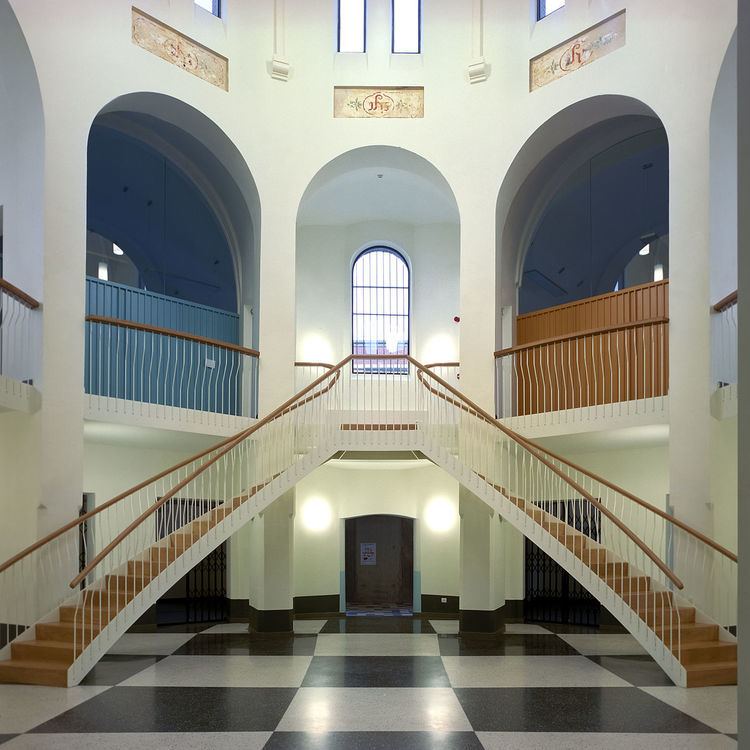Administrative staff ± 1,100 (2014) Location Hasselt, Belgium Colours red, blue Founded 1971 Rector Luc de Schepper | Students ± 5,500 (2014) Campus Diepenbeek and Hasselt Phone +32 11 26 81 11 Motto 'Knowledge in Action' | |
 | ||
Established 1971 (UHasselt since 2005) Address Martelarenlaan 42, 3500 Hasselt, Belgium Affiliation Transnational University Limburg Similar University of Antwerp, Katholieke Universiteit Leuven, Vrije Universiteit Brussel, Ghent University, University of Mons Profiles | ||
Hasselt University (Dutch: Universiteit Hasselt) is a university with campuses in Hasselt and Diepenbeek, Belgium. It was officially established in 1971, as the Limburgs Universitair Centrum (LUC). On June 15, 2005 the university changed its name to Hasselt University.
Contents
- History
- International collaborations
- Limburg Association of Higher Education
- New city campus
- Higher education reform
- Campus Hasselt
- Campus Diepenbeek
- Figures
- Institutes
- Student organisations
- Honorary Degrees
- Honorary Doctors Hasselt University
- References
Currently, the universities of Hasselt and Maastricht work together as the Transnational University Limburg (tUL). Together with Hogeschool PXL (the former XIOS en PHL), it established the Limburg Association of Higher Education (AUHL).
The rector of the university currently is Prof. Luc de Schepper, the vice rectors are Prof. Karin Coninx and Prof. Jean-Michel Rigo.
History
Hasselt University was officially established in 1971 as ‘Limburgs Universitair Centrum’ (LUC), but it was not until 1973 that the university – literally – opened its doors and welcomed its first students. Until 1991 the university was, in fact, an undergraduate level university institution with two faculties: the Faculty of Medicine-Dentistry and the Faculty of Sciences (with study programmes in Mathematics, Physics, Computer Science, Chemistry and Biology). In 1991 the university expanded the reach of its curriculum by transforming the Limburg Business School (Economische Hogeschool Limburg), an independent university college which was located on the same campus in Diepenbeek, into the Faculty of Applied Economics. At the same time, Hasselt University became entitled to organize postgraduate programmes and award doctoral degrees in its three faculties.
International collaborations
In 2001 the Flemish and Dutch Ministers of Education signed an International Treaty by which the transnational University Limburg (tUL) was founded. Academic staff from Hasselt University and from nearby Maastricht University (in the Dutch Province of Limburg) since then jointly undertake research activities and offer degree programmes in Life Sciences and Computer Sciences.
Limburg Association of Higher Education
In 2002 Hasselt University, together with Hogeschool PXL established the Limburg Association of Higher Education (AUHL). The AUHL was founded to enhance cooperation between higher education institutions in the region.
New city campus
In the past decade Hasselt University has expanded its curriculum thoroughly. Since September 2004 the university offers a unique programme (bachelor and master) in Transportation Sciences. A bachelor programme in Law was established in September 2008, in cooperation with Maastricht University and KU Leuven. Three years later a master programme in Law was created.
2012 proved to be a new milestone in the university’s young existence, with the inauguration of the ‘city campus’ in Hasselt.
Higher education reform
In September 2013 four new (bachelor and master) programmes were added to the university’s curriculum: Architecture, Interior Design, Rehabilitation Sciences & Physiotherapy and Industrial Sciences. This expansion also entailed the creation of two new faculties: the Faculty of Architecture & Arts and the Faculty of Engineering Technology. That brings the total number of faculties to six, alongside the Faculty of Business Economics, Faculty of Medicine & Life Sciences, Faculty of Sciences and the Faculty of Law. In 2014, the School of Transportation Sciences was established.
Hasselt University is home to about 6,000 students and 1,200 academic, administrative and technical staff members.
Campus Hasselt
The head office of Hasselt University is located at campus Hasselt. The complex consists of three buildings, located near each other: the Vice Chancellor’s Office Building, the Faculty of Law and the ‘Oude Gevangenis’ (the renovated ‘Old City Jail’). The former city prison provides a new home to primarily law students, with several study rooms and two auditoriums. The Student Service Center, where enrollment of new students takes place, is also located in the ‘Oude Gevangenis’.
Campus Diepenbeek
Since 1973 Hasselt University is located on the Campus Diepenbeek, which occupies an 75 acres site. Moreover, several institutes for applied research, an incubator for starting small enterprises, and several small businesses interacting with the research activities of the university are located on campus Diepenbeek. Building D includes the agora, the student restaurant and the library.
Figures
Student population:
In 2016 15% fewer students enrolled for the new academic year, with just 1250 freshmen starting.
Staff population: On February 1, 2014, 1,100 staff members were employed at Hasselt University.
Institutes
Hasselt University has seven research institutes:
Student organisations
The most important student organisation is the Student Council or StuRa. This body of 14 elected students makes sure the student's rights are respected in every way. The chairman also has a seat in the university's Board of Governors.
Other student organisations at Hasselt University are:
Honorary Degrees
Over the past four decades, Hasselt University has bestowed 53 honorary degrees. In 2013, Martin Cooper - also known as 'father of the mobile phone' - joined the UHasselt Honorary Doctors. He was nominated by the Student Council.
